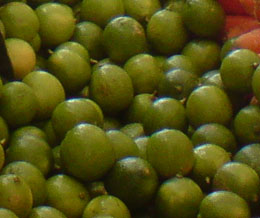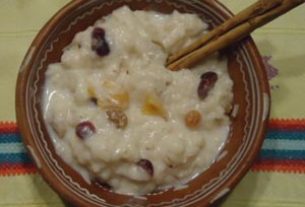In Mexico, the lime — known as a limón — is everywhere, served with nearly all food except coffee and dessert (and some desserts are made with them) and sold in even the smallest neighborhood stores. Here, limes are considered a necessity, and almost no kitchen is without them.

Wedges of lime accompany everything from morning plates of fruit to late night tacos, and are served with salads, seafood cocktails, fish dishes, grilled beef, soups, and even snacks like roasted peanuts. Many years ago, when I first had cocktails with new friends here in Mexico, I was somewhat surprised when the waiter brought lime wedges with the peanuts, and even more surprised when one of the group squeezed liberally, dousing the peanuts, skin and all, with the aromatic juice. He didn’t ask whether anybody didn’t want lime, because apparently everyone did.
And speaking of cocktails, it seems like most of them either have lime in them or come with a lime garnish. They are an important element in the beer beverage called michelada, in the rum and coke drink cuba libre, and of course in margaritas. A non-alcoholic drink called limonada preparada is made with lime juice and club soda, and then there is agua de limón, made with either the fruit juice or leaves.
The Mexican lime, Citrus aurantifolia, is prized for its special bouquet and unique flavor, but here in Mexico, it has many medicinal uses. Limes in the kitchen do double duty, used in both cooking and home remedies. This smallest member of the citrus family is taken internally and applied externally to treat a wide range of ailments.
Years ago, when I was still commuting by bus from Cholula to the university in Puebla, I bought a small paperback from a vendor who got on board hawking something called the Antigua Formulario Azteca, a collection of home cures using all manner of fruit, vegetables and herbs, from boiled celery compresses for varicose veins to radish peels to treat anemia. A fairly long section of this little gem, which I still have, is entitled “Lime Is the Best Medicinal Gift.”
Lime juice is enthusiastically recommended for an assortment of maladies from insomnia (drink the juice of 10 limes a day for three days, and sleep well on the fourth night) to tired eyes (boil the petals from a rose of Castille in a liter of water, allow to cool, and add five drops of lime juice to make eye wash.) I can’t say that I’ve tried either of these, but I can attest to the book’s lime and onion combination to treat respiratory problems.
A couple of years ago, one of my Cholulteca cooking gurus, Juana Perez, dropped by and found me in bed with what was becoming a case of bronchitis. She went to the kitchen and rounded up a half an onion, a couple of limes and some honey, put it all in the blender, lime peel included, and watched as I reluctantly downed the concoction. It doesn’t taste nearly as bad as it sounds, and works fast to eliminate congestion.
Limes are also recommended as a digestive aid, and this is one reason why they are served with so many other foods. Even before they enter the mouth, their aroma begins to stimulate salivary glands, and the acid in the fruit does the rest to breakdown macro molecules of food. Flavenoids in limes increase the production of digestive juices, making heavy meals easier to digest.
Long known as a cure for vitamin C deficiency, lime is also used to treat gout. In Mexico, those suffering from gota are advised to drink the juice of half a lime mixed into a glass of water twice a day. This helps combat the inflammation because citric acid breaks down uric acid, the buildup of which is the culprit in gout pain.
Limes are also beneficial for the skin, applied externally to scrub off dead skin cells and to help in the healing of rashes. Rubbing with a lime is the number one advice given by residents of the tropical regions of Mexico to relieve the sting and itch of insect bites. And its high content of vitamin C and flavenoids, both of which are antioxidants with antibiotic and disinfectant properties, means that consuming lime juice helps skin from the inside, too, protecting it from infections and reducing body odor.
One of lime’s most touted uses is as an aid in weight reduction. The landlady of a vacation home we rented in Baja California was in her eighties but had the face and figure of a much younger woman. Her “secret” was drinking the juice of a lime in a glass of warm water first thing in the morning and last thing at night. The weight loss connection is likely due to lime’s high potassium content, effective in flushing toxic substances out of the body.
The oil extracted from the lime’s peel is used in body oil, cosmetics and a wide array of toiletries. A study conducted a few years ago at the Smell and Taste Institute in Chicago found that citrus scents actually made people perceive the wearer as being up to ten years younger.
Originally from the Indo-Malay region and brought to the New World by the Spaniards, the diminutive fruit does so well in the tropical regions of Mexico that it is known even outside the country as Mexican lime. Another name for Citrus aurantifolia is West Indian lime and, according to information from the horticultural department at Purdue University, the Mexican lime and the Key lime are botanically the same.
The vigorous Mexican lime tree has the exotic history of many foods that came to this country with the Europeans, having traveled from the Indo-Malay region to North Africa with Arabs, and from there to the Mediterranean with the Crusaders. Limes continue to be cultivated on a commercial scale primarily in Mexico, India, Egypt and the West Indies, and on a lesser scale in other tropical parts of the world. There are two million seedling lime trees in Colima alone, and Mexico raises limes for fresh fruit sale as well as for the exportation of juice and lime oil.
Whether in beverages, soups, salads, main courses or desserts, lime adds a bright flavor and a Mexican touch to countless dishes. Here are some new recipes with lime and some from past columns.
- Mexican beer cocktail: Michelada
- Refreshing Mexican lime water or limonada: Agua de limón
- Refreshing Mexican lime leaf drink: Agua de hojas de limón
- Yucatecan lime soup: Sopa de lima
- Baby greens with pumpkin seeds and Mexican Lime Vinaigrette: Ensalada verde con pepitas y vinagreta de limón
- Mexican grilled chicken in lime marinade: Pollo a la parilla con marinada de limón
- Mexican tequila lime pie: Pay de limón con tequila

